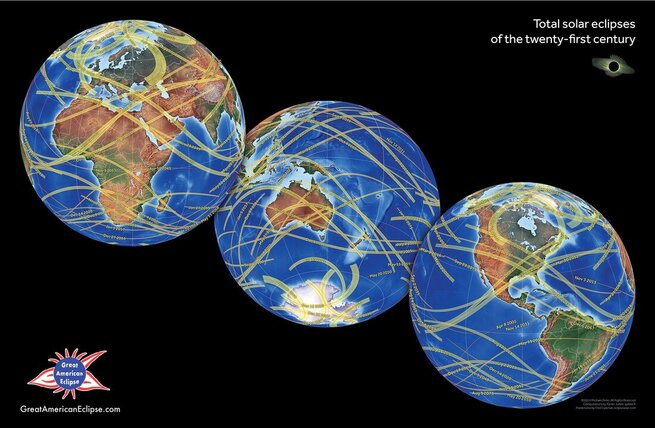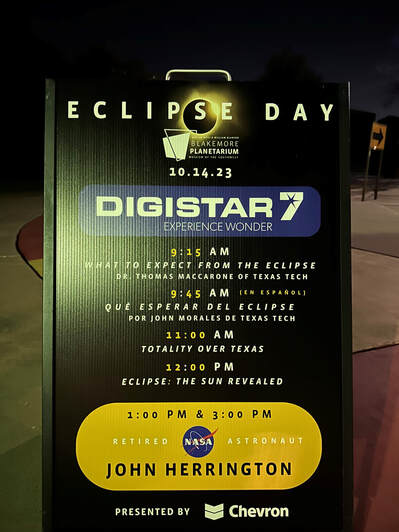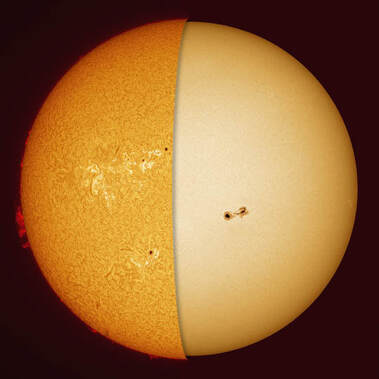The Path of an Eclipse
The path of a total solar eclipse is the area on the surface of the earth that will be under the moon's shadow throughout the event. Mathematics predicts both the timing and the location of the shadow's path very precisely. This is represented by the yellow curves on the motion maps below, which show three of the eclipses featured in this article. Note that the dark, circular lunar shadow determines the overall path. This shadow, the umbra, means there will be a TOTALLY eclipsed sun for anybody along the path. Note also the circular shadow gradient extending from the umbra toward the large moving circle drawn on the maps. This gradually lighter shadow, the penumbra, covers viewers across the continents where the eclipse will be seen only PARTIALLY. As such, the closer one is to the solid umbral shadow, the more of the sun will be blocked by our moon.
The first map (left) shows the path for the August 2017 TOTAL eclipse, which I featured earlier in this article. Tracing a path west to east across the middle of North America, I began my eclipse "chase" the day prior by heading north through Arkansas (where I picked up a dear friend) and then to Missouri, where I hoped to intercept the eclipse path. However, weather had a different plan for me, requiring me to drive east, over-night toward Kentucky, where a clear weather window would be. I settled in a Walmart parking lot in Hopkinsville, Kentucky with nearly 200 other chasers. The city of nearly 31,000 people swelled to over 100,000 people, according to city government estimates. This illustrates the economic impact that such an eclipse event can have on a location, which must be taken into account when planning your "chase." There will be crowds!
We were rewarded with the most incredible experience, which also offered the longest duration of totality of anywhere along the eclipse path, making Hopkinsville one of the more desired locations to be. Speaking of which, it is estimated that 12.25 million people lived within the path of this eclipse, with an estimated 21 million others traveling to the eclipse path to see totality.
Compare that with 31 million people living with the eclipse path for the April 2024 Total Solar Eclipse, as shown on the map at right. I've seen estimates of 4 million people travelling to see it. However, I believe these numbers will be somewhat skewed by the fact that much of that resident population will still hit the roads in order to maximize the time of totality. For example, downtown Dallas will offer 3 minutes and 51 seconds of totality, but travelling south to nearby Ennis will gain 31 seconds, something many of us find worth doing. Likewise, April is cloud season for Texas, so the likelihood of a "chase" is greater than normal.
Regardless of however many people travel, this is something to keep in mind when planning for the April 2024 event. In fact, almost ALL lodging or visitor accommodations in the Hill Country region of Texas will have been reserved up to a year prior, so lodging will need to be found in the larger cities, like the DFW area, Waco, Austin, or San Antonio. Expect higher prices!
The path of totality will cross over the United States from the tip of Baja Mexico, through the heart of Texas, and up through Maine in the northeast part of the country, so travelling to Texas is not a requirement. However, totality is longer the further south you go, as well as providing an increased likelihood for better weather. The longest duration of totality will be in Nazas, Mexico, where the duration of totality is 4 minutes and 28.13 seconds. But viewing along the center-line of the eclipse anywhere in Texas will still offer over 4 minutes of totality, which is almost double the time of the 2017 event.
The first map (left) shows the path for the August 2017 TOTAL eclipse, which I featured earlier in this article. Tracing a path west to east across the middle of North America, I began my eclipse "chase" the day prior by heading north through Arkansas (where I picked up a dear friend) and then to Missouri, where I hoped to intercept the eclipse path. However, weather had a different plan for me, requiring me to drive east, over-night toward Kentucky, where a clear weather window would be. I settled in a Walmart parking lot in Hopkinsville, Kentucky with nearly 200 other chasers. The city of nearly 31,000 people swelled to over 100,000 people, according to city government estimates. This illustrates the economic impact that such an eclipse event can have on a location, which must be taken into account when planning your "chase." There will be crowds!
We were rewarded with the most incredible experience, which also offered the longest duration of totality of anywhere along the eclipse path, making Hopkinsville one of the more desired locations to be. Speaking of which, it is estimated that 12.25 million people lived within the path of this eclipse, with an estimated 21 million others traveling to the eclipse path to see totality.
Compare that with 31 million people living with the eclipse path for the April 2024 Total Solar Eclipse, as shown on the map at right. I've seen estimates of 4 million people travelling to see it. However, I believe these numbers will be somewhat skewed by the fact that much of that resident population will still hit the roads in order to maximize the time of totality. For example, downtown Dallas will offer 3 minutes and 51 seconds of totality, but travelling south to nearby Ennis will gain 31 seconds, something many of us find worth doing. Likewise, April is cloud season for Texas, so the likelihood of a "chase" is greater than normal.
Regardless of however many people travel, this is something to keep in mind when planning for the April 2024 event. In fact, almost ALL lodging or visitor accommodations in the Hill Country region of Texas will have been reserved up to a year prior, so lodging will need to be found in the larger cities, like the DFW area, Waco, Austin, or San Antonio. Expect higher prices!
The path of totality will cross over the United States from the tip of Baja Mexico, through the heart of Texas, and up through Maine in the northeast part of the country, so travelling to Texas is not a requirement. However, totality is longer the further south you go, as well as providing an increased likelihood for better weather. The longest duration of totality will be in Nazas, Mexico, where the duration of totality is 4 minutes and 28.13 seconds. But viewing along the center-line of the eclipse anywhere in Texas will still offer over 4 minutes of totality, which is almost double the time of the 2017 event.
In the center map, we see the path for the ANNULAR solar eclipse which occurred this past October 14, 2023. This eclipse, so named after the annulus of light that appears at maximum eclipse, traced a path across North America from northwest to southeast, cutting through west Texas just after noon local time. At over 5 minutes of "annularity," seeing the sun shining around the moon's silhouette as a RING OF FIRE is nothing short of incredible. I intercepted this eclipse path in Midland, Texas, where I set up at a park, where the neighboring planetarium had a variety of public activities, guest speakers, and eclipse viewings. Check out my Ring of Fire video of that eclipse, and the excitement it brings, posted just below.
|
|
One aspect of being in the path that we should note is that being near the path's "centerline" offers the longest duration of totality. Living in the Dallas-Fort Worth Metroplex, I know most people will try to view the event from their own backyard. This affords convenience, of course, but it will shorten the total eclipse duration. For example, the table above shows that Dallas will get 3m 47s of totality. But notice that Fort Worth only gets 2m 34s. Now this might be sufficient for you, but if you have plans to carefully observe or photograph the event using equipment other than a pair of binoculars or your solar glasses, then you will want to maximize that time.
Ironically, I grew up in a house near Eagle Mountain Lake just northwest of Fort Worth and it is TWO HOUSES outside of the edge of the eclipse path. You will NOT see the show from there...you will miss it entirely. Err on the side of caution and take a 10 minute drive to assure totality. If you live in Denton, you should be heading south since you will also miss totality entirely if you stay there. Same story with those living in the San Antonio and Austin areas. Do NOT assume you are good to go! You too will likely need to drive north or northwest to be within the path of totality. |
Because those huge cities are just on the edge of the eclipse path, there will be concerns about the amount of traffic on that day. Traffic is bad enough on a typical Monday, but if you plan to drive near these cities while the eclipse is occurring, then you should expect a massive headache! In Texas, specifically, Interstate 35 (especially East I-35 towards Dallas), State Hwy 67, and State Hwy 287 will be congested. For this reason, many school districts within the path of totality, especially those along those highways, will cancel school on those days. This is because the end of the eclipse happens to coincide right around 3PM, which is too close to the typical release time of many schools. EDIT: As of March 6, 2024, a large number of districts in Texas have canceled school already, including the ISDs of Hillsboro, Ennis, Corsicana, and Waxahachie.
My advice is to arrive early in the morning to your setup destination. If there is ever a time to wake-up at 3AM, this is that time!
These particulars concerning our bigger Texas cities nearest the eclipse path can be seen in the images below. These maps refine the paths for totality to show both the estimated time that totality will begin, as well as the amount of totality duration gained by being closer to the path's centerline.
On the left, we see the DFW area, with the Austin and San Antonio area on the right. These maps, and the motion maps above, are courtesy of www.greatamericaneclipse.com and is one of many excellent resources online for planning your event.
My advice is to arrive early in the morning to your setup destination. If there is ever a time to wake-up at 3AM, this is that time!
These particulars concerning our bigger Texas cities nearest the eclipse path can be seen in the images below. These maps refine the paths for totality to show both the estimated time that totality will begin, as well as the amount of totality duration gained by being closer to the path's centerline.
On the left, we see the DFW area, with the Austin and San Antonio area on the right. These maps, and the motion maps above, are courtesy of www.greatamericaneclipse.com and is one of many excellent resources online for planning your event.
Perhaps even better is this Interactive Google Map for the eclipse made by Xavier M. Jubier. Click on your location anywhere on the map to see the particulars for your area, including times for all contact phases, time of totality, and time of partiality for those who are not in the path of totality.


































